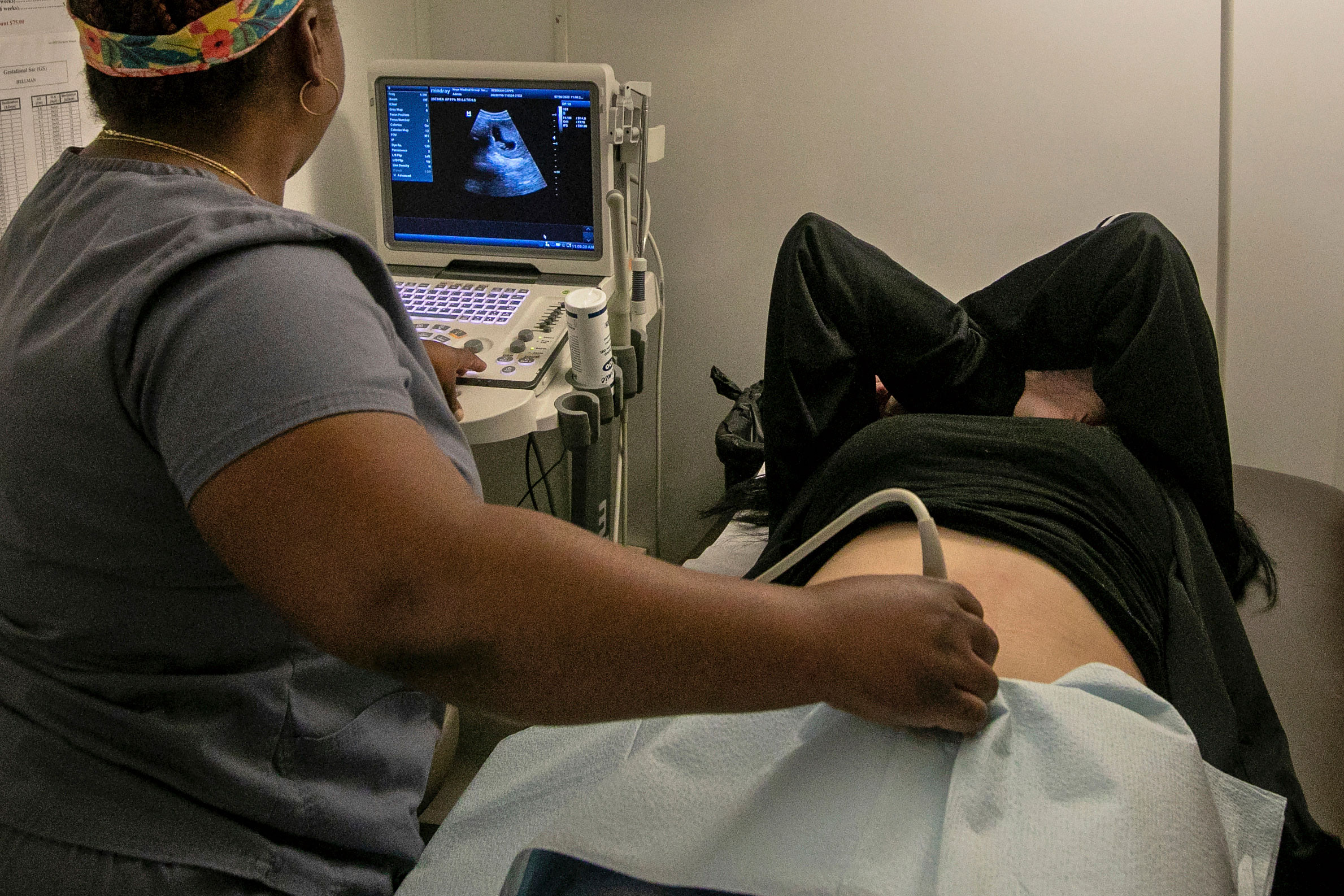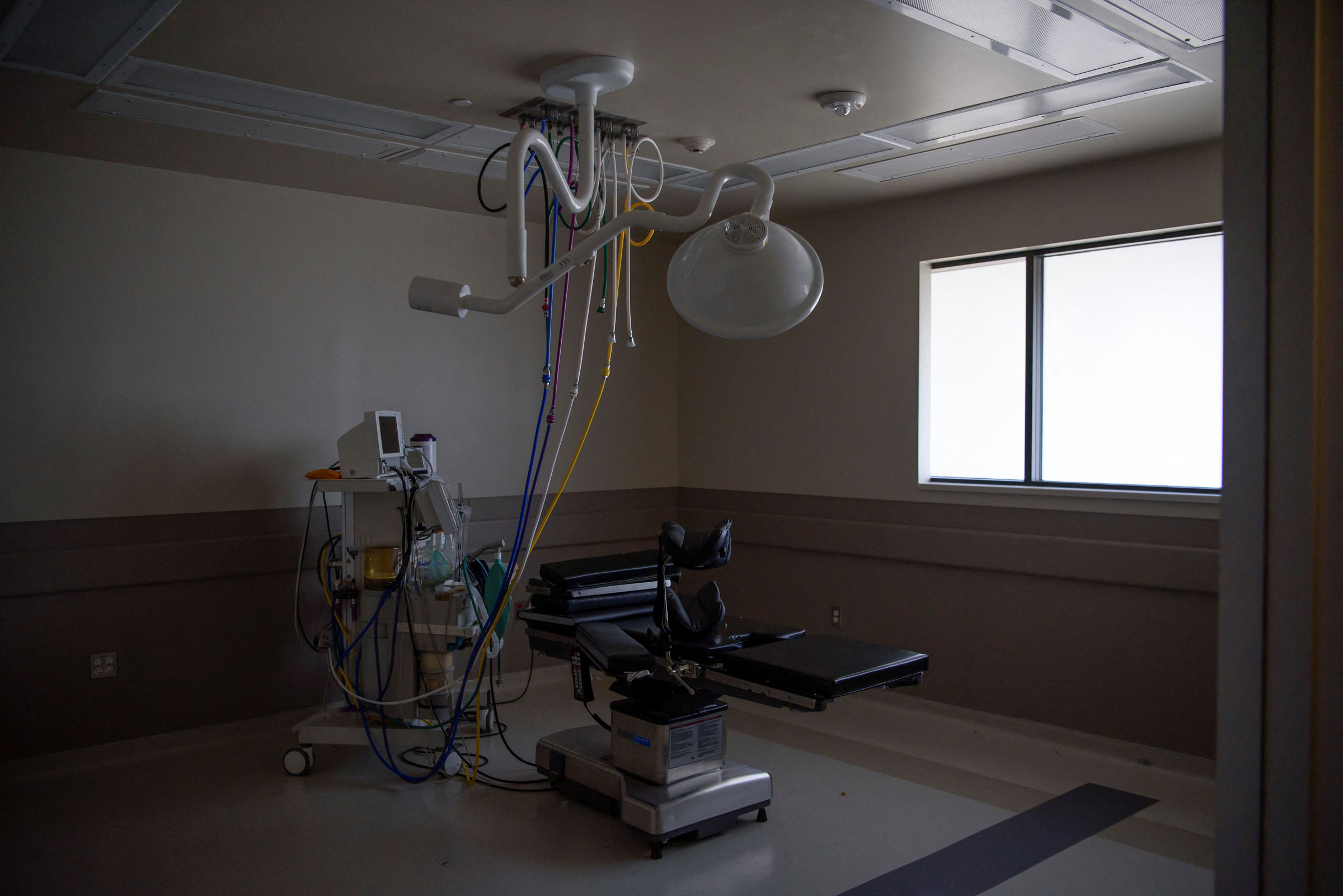
A few days after the Supreme Court eliminated the constitutional right to abortion in June, Dr. Mae Winchester got a call late at night. One of her patients had developed sepsis after her water broke at 19 weeks of pregnancy. Sepsis can be fatal, and normally Winchester, a maternal-fetal medicine physician in Ohio, would rush her patient into the operating room and provide an abortion. But this time, she felt she had to call her hospital’s lawyers first.
The lawyers agreed that treating this patient with an abortion would be legal under Ohio’s new abortion ban, which contained an exception to prevent the death of the mother. But in other cases, Winchester says care has been delayed, or the lawyers have disagreed with her, and she hasn’t been allowed to provide the care she deems necessary. “Meanwhile, the patient is just sitting in the operating room by herself,” Winchester says, “not knowing what I can do.”
Winchester is just one of many doctors throughout the country struggling to navigate the complicated and rapidly shifting legal landscape of abortion after the Supreme Court overturned Roe v. Wade with its decision in Dobbs v. Jackson Women’s Health Organization. With abortion rights now left up to the states, physicians and other medical providers are confused about what services they are legally allowed to provide, often forced to consult lawyers on decisions they used to be able to make on their own, and scared for their patients’ lives.
In Wisconsin, where a ban dating back to 1849 prohibits all abortions except to save the life of the pregnant patient, groups of lawyers and doctors are collectively trying to come up with guidance on what situations pose a serious enough threat to a patient’s health to justify an abortion. In Texas, some hospitals have created committees to review such situations, while others have established protocols requiring multiple doctors to sign off on medically necessary abortions. With a state law allowing private-citizen lawsuits in effect, physicians are concerned that anyone—from a local politician to a patient’s family member to a nurse or cleaning staff member—could file suit if the person disagrees with their decision. And in Idaho, the state’s total abortion ban has led doctors to discuss medically transporting patients out of state if they need serious treatment and drastically affected care for even ectopic pregnancies, a condition in which a fertilized egg implants outside the uterus, making the pregnancy nonviable and potentially life-threatening if untreated.
TIME spoke with more than a dozen doctors, health care lawyers, and hospital ethics committee members in nine states, who all said their efforts to interpret state laws are failing to clarify the chaos of conflicting, sometimes century-old or hastily written laws. Those laws have created new regulations, reporting requirements, penalties, and definitions that many argue do not take into account the complex and inherently dangerous reality of pregnancy.
For a half-century, physicians have provided abortions to treat a wide range of medical situations including hemorrhaging, miscarriages and even cancer. Now 14 states ban or tightly restrict abortion, with at least 10 other laws tied up in court. Most provide only narrow exceptions. The laws are often vague, and the few that try to spell out conditions that qualify for abortions do not cover all possibilities. Doctors say they are being forced to navigate legal concepts they don’t have the training for while being prohibited from using their own expertise to treat patients. Attorneys with little experience in reproductive health care say they are likewise scrambling to understand complex medical situations and develop procedures for ever-growing lists of complications, knowing their guidance could be challenged any time someone disagrees with their interpretation of untested laws. Many warn the dynamic will permanently change the doctor-patient relationship.
While some physicians and lawyers have spoken out about this dynamic, many others are afraid to do so. Some universities and hospitals have told their staff not to give interviews about abortion, while others have made it clear they would rather their staff not speak publicly or have said they can only do so without identifying their employer. Doctors and lawyers at major private and public institutions in multiple states told TIME they weren’t comfortable speaking about their handling of abortion post-Roe, and many of those who did said they would only do so as private citizens, unaffiliated with their official positions.
Already, doctors and lawyers say that the threat of criminal penalties, massive fines, or lost licenses is affecting how and when they decide to proceed with abortions, often leading to delays in care. “This assignment of criminal penalties has made our physicians much more interested in trying to interpret the statute, and they’re taking a much more conservative view,” says Lisa Larson-Bunnell, a lawyer at a hospital in Missouri, where a trigger law banned all abortions except in cases of medical emergency hours after the Supreme Court’s decision.
The doctors who spoke with TIME all emphasized that when patients are imminently dying, they have intervened and would do so again. But there are plenty of situations when a pregnancy is seriously harming a patient’s health or a patient is experiencing a problem that could quickly become dire, doctors say, and delays caused by the new laws make those situations more dangerous. Doctors are not used to discussing their medical decisions with hospital lawyers, says Dr. Alison Haddock, an emergency medicine physician in Houston and board chair of the American College of Emergency Physicians. Before her state outlawed abortion, it was “exceedingly rare” to talk to a lawyer during her shift, and those conversations would more likely revolve around guardianship for an elderly patient or someone with psychiatric or social work needs. “Not where you have a patient who is medically quite ill in front of you, and you know the treatment plan and can’t complete it,” she says.
For many doctors, explaining the new order of operations to patients is just as difficult as processing it themselves. “I went into this field to be able to help patients and their families get the best pregnancy outcome that’s possible and to be their support and their guidance through difficult times,” says Dr. Kylie Cooper, a maternal-fetal medicine physician in Boise, Idaho. “I have patients asking me, ‘Are you going to be able to help me if something unexpected or dangerous happens?’ And for the first time in my career, I have to tell them that I don’t know.”

Varying guidance
In many states, decisions about how to comply with abortion bans vary by city or even by hospital, as different institutions establish their own guidance. This variation is “one of the worst things that can happen,” says Larson-Bunnell. “There is solidarity in numbers. And when you have individual physicians and you have individual hospitals or health systems that are behaving differently, that causes there to be more scrutiny on hospitals when they do decide to proceed with an abortion.”
Cooper and other ob-gyns at her hospital have formed a committee to help advise other physicians and medical staff on how to care for patients under the state’s new abortion ban, which technically has no exceptions that would protect doctors from being charged, and says that providers can defend themselves from criminal prosecution by arguing an abortion was necessary to save the pregnant woman’s life. A judge ruled in August that physicians in Idaho must be allowed to provide abortions in medical emergencies, but Cooper says the law is still causing confusion and adding legal and logistical hurdles for all pregnancy care in the state. In many cases, the lawyers advising physicians on navigating these laws are malpractice attorneys or hospitals’ general counsels, not specialists in reproductive health.
Winchester’s hospital added forms that are designed to document how any abortion situation falls under the law’s exceptions. “Our physician notes used to be just for physicians to communicate, and now it has become: this is what’s going to protect me if someone comes after me because of my medical care,” Winchester says. (Ohio’s abortion ban is now blocked, but the state’s attorney general is appealing the judge’s decision.)
Read More: ‘Never-Ending Nightmare.’ An Ohio Woman Was Forced to Travel Out of State for an Abortion
When Texas implemented new laws last fall banning abortions after about six weeks and limiting abortion medications, Dr. Patrick Ramsey, maternal-fetal medicine fellowship director at University of Texas Health Science Center in San Antonio, worked with the legal department at his institution to create a list that could serve as a starting point for discussions about which conditions would threaten a pregnant patient’s life or be considered a medical emergency. They then instituted new policies requiring two attending physicians to sign off on procedures in some cases, added extra documentation to their electronic medical records to match the state’s new laws, and decided that no residents, who are still completing their training, would be responsible for documenting these cases. “It’s creating more administrative headaches and taking away from patient care,” Ramsey says.
The confusion extends beyond obstetrician-gynecologists to include emergency physicians, family medicine doctors, oncologists, pediatricians, and more. In large hospitals, doctors can ask an ob-gyn to advise on a pregnant patient, but in smaller hospitals or rural areas, emergency physicians often provide obstetric care and may have to make decisions on their own or wait to hear back from a larger institution elsewhere, says Dr. Daniel Elliott, board president of the Indiana chapter of the American College of Emergency Physicians.
Some hospitals are involving ethics committees or clinical ethicists, who can provide bedside consultations for doctors making tough decisions. But this will be limited by each state’s law and a given institution’s risk tolerance, says Micah Hester, who chairs the department of medical humanities and bioethics at the University of Arkansas for Medical Sciences College of Medicine and consults on cases at UAMS hospitals. Even in risky medical situations, “any ethics committee or ethicist would be hard pressed to recommend going against the law,” he says, “knowing that doing so puts the provider and the woman at certain kinds of very important legal risks.”
The varied statutes and penalties, combined with frequent legal changes, have made it difficult to provide uniform advice. The American College of Obstetricians and Gynecologists (ACOG), for example, recommended that hospitals form task forces to help doctors make decisions about what medical emergencies fall under their state laws’ exceptions, but it cautioned that it would be “impossible” and “dangerous” to create a finite list of conditions for doctors to follow. The Wisconsin Medical Society moved away from providing specific recommendations and has opted for webinars and ongoing updates to its members about the state’s ban. The American College of Emergency Physicians (ACEP) has formed a national task force of doctors, policy experts, and lawyers to try to help its members navigate emergency care under state abortion bans. But even when groups do issue documents breaking down their state’s laws, they can’t predict how individual prosecutors will react.
Even some hospitals that have provided guidance or put committees in place have sometimes told physicians to make decisions on their own on a case by case basis because if they are performing an abortion, it should be a true emergency. “It’s just, there you are, out there on an island,” says Dr. Jennifer Smith, an ob-gyn in the St. Louis area.
‘Am I a felon?’
The restrictive state laws put physicians “between a rock and a hard place,” says Dr. Wendy Molaska, a family medicine physician in Wisconsin and president of the Wisconsin Medical Society.
The federal Emergency Medical And Labor Treatment Act (EMTALA) requires emergency departments to stabilize any patient who arrives in an emergency or in labor, or transfer them to a facility that can treat them. If physicians trying to comply with abortion bans that only include life exceptions wait too long, Molaska says they fear hurting the patient—and violating federal law in the process. That gives them an impossible choice, she says: “Am I a felon? Or am I a malpracticing physician?”
Medical malpractice insurance doesn’t cover criminal charges, and most doctors don’t have their own legal advisers. Dr. Judith Williams, an ob-gyn in Memphis, works in private practice and treats patients at two hospitals in her area. Neither of them have provided guidance on the state’s abortion law, which, like Idaho’s ban, prohibits abortion in all circumstances—with no exceptions for lifesaving care—and only allows providers to argue they were acting to save the patient’s life or prevent “serious risk of substantial and irreversible impairment of a major bodily function” as an affirmative defense. Williams asked how her hospitals were handling the new law, and says she was told the institutions wouldn’t offer guidance because their lawyers did not handle criminal cases. So instead, she spoke to a patient who is a criminal defense attorney for legal advice. And when Williams recently had a different patient whose fetus was diagnosed at 19 weeks with anencephaly—a condition in which the fetus’ brain doesn’t develop—she called her lawyer patient to ask whether she could help the other woman find an abortion in another state. “When I called her, she said, ‘Probably the best thing that you can do is just give the patient her prenatal records and don’t have on paper anywhere that you facilitated this,’” Williams says. “That is terrible.”
A number of high-profile cases of patients being denied care in life-threatening or emergency situations have emerged in the months since the Supreme Court overturned Roe. But while some anti-abortion doctors have argued that these instances are rare and that state laws do allow providers to treat those patients, other physicians say such situations are happening regularly. High-risk ob-gyns in multiple states told TIME they are seeing patients on a weekly basis whose care is affected negatively by their states’ abortion laws.
Evidence backs them up. A study of two hospitals in Dallas from the first nine months after Texas’ six-week abortion ban took effect in September 2021 found that patients had to wait an average of nine days for their pregnancy complications to be considered life-threatening enough to qualify for an abortion. Because of these delays, most of the patients observed experienced serious health consequences, including hemorrhaging, sepsis, and in one case a hysterectomy.
Some anti-abortion politicians have acknowledged the laws are causing issues in recent months. Republican lawmakers in South Carolina spoke out after hearing stories of harrowing experiences from their constituents, and despite the state calling a special session to pass new abortion restrictions last month, lawmakers have not been able to agree on a new bill. But in other cases, they are insisting the laws provide appropriate exceptions and doctors are interpreting them incorrectly. In Texas, state Sen. Bryan Hughes, who helped author his state’s six-week ban, wrote a letter to the Texas Medical Board in August raising concerns about “allegations that hospitals, their administrations, or even their lawyers may be wrongfully prohibiting or seriously delaying physicians from providing medically appropriate and possibly life saving services” to patients with pregnancy complications. “Texas law makes it clear that a mother’s life and major bodily function should be protected,” and any allegation “should be investigated,” he wrote, according to the letter, which has not been previously reported.

More doctors have started to speak up about their concerns. A coalition of medical groups, including the ACEP, ACOG, and the American Medical Association, filed amicus briefs in two cases about EMTALA laying out the many harms they say the laws can cause, and other providers have written op-eds in their local newspapers and testified when states have considered new abortion bans. But in the meantime, doctors worry about how the confusion and stress will affect their patients and their ability to practice long-term. Doctors in multiple states told TIME that they or their colleagues are relocating to states with fewer abortion restrictions.
Shortages of ob-gyns and primary care providers are common around the country, and maternity care deserts are growing. A new report released Oct. 12 by March of Dimes found that 36% of counties nationwide have no obstetric hospital or birth center and no obstetric providers, with many of the highest concentrations of these care deserts in states that now ban abortion. States that restrict abortion also have high maternal and infant mortality rates and worse birth outcomes, something that doctors predict will worsen if more providers decide they can’t practice there. “The price that citizens of Texas are going to pay for this over the next decade or two will be unfixable,” says Dr. Charles Brown, chair of the Texas district of the American College of Obstetricians and Gynecologists.
Those that do remain say they are still worried about practicing under the new laws, but are trying to provide the best treatment they can. “Do you want your patient to be the example of what can go wrong?” says Williams in Tennessee. “I really do not want that to occur at my hands. And I simply am not going to let it occur at my hands.”
More Must-Reads from TIME
- L.A. Fires Show Reality of 1.5°C of Warming
- Home Losses From L.A. Fires Hasten ‘An Uninsurable Future’
- The Women Refusing to Participate in Trump’s Economy
- Bad Bunny On Heartbreak and New Album
- How to Dress Warmly for Cold Weather
- We’re Lucky to Have Been Alive in the Age of David Lynch
- The Motivational Trick That Makes You Exercise Harder
- Column: No One Won The War in Gaza
Write to Abigail Abrams at [email protected]